by Natalie Guzman | Dec 3, 2020
Before I even started high school, I knew I wanted to become a physician. However, after my freshman year of college, I questioned whether I would make that dream come true. I was struggling to maintain my STEM GPA, and I believed I just was not cut out for medicine. I was ready to give up, but then I participated in the Biomedical Research Internship for Minority Students (BRIMS) at Cincinnati Children’s Hospital. This program gave me the courage and confidence to continue pursuing medicine. I was able to network with highly successful minority physicians, learn new study techniques, and most importantly, I gained a new outlook.
During the BRIMS program, I discussed the struggles I faced with science courses my freshman year. Through workshops with my colleagues and mentors, I realized that my public-school College Preparatory Chemistry course during 10th grade might have left me with less of a foundation than some of my classmates. This by no means meant I was not as intelligent or qualified, but it did mean that I needed to take the extra time to strengthen my foundation moving forward. Going into my sophomore year of college, I no longer saw my knowledge gaps as incompetence, but something I could work through by going to office hours and seeking out additional resources like Khan Academy videos. Unfortunately, many students are not able to participate in programs like BRIMS and in their case, they may decide to give up on medicine just as I would have if I did not participate in the BRIMS program.
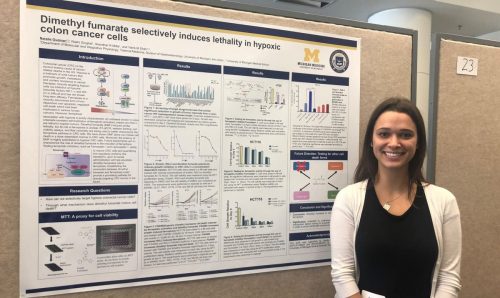
My UM SMART poster presentation.
Many students who are from populations that are underrepresented in medicine (URiM) face significant barriers to becoming a physician. Whether that be a lack of foundational knowledge as in my case, low standardized test scores, lack of representative mentorship, financial barriers, imposter syndrome, and so much more. For many URiM students these challenges become prohibitive to applying to medical school, leading to a lack of diversity in the field. During my junior year of college, I decided to not only apply to medical school but also pursue a PhD because of my strong research interest.
The lack of diversity was amplified amongst the physician-scientist field. MD/PhD programs are notoriously selective and competitive. The years of research experience needed, high median MCAT, and lack of representative physician-scientist mentors with a culmination of other factors have resulted in a field that lacks diversity. In 2019, out of 579 MD/PhD graduates, 5.35% were Black, 5.17% were Hispanic, and 0 were Native Hawaiian or Other Pacific Islander (https://www.aamc.org/media/8231/download).
With such a low number of URiM students in the MD/PhD field, it is clear change needs to be made in order to strengthen the pipeline for aspiring URiM physician-scientists. This summer, I collaborated with URiM MD/PhD students at Emory, Stanford, and the University of Pennsylvania to address this very problem. We wrote a paper that discusses the challenges URiM applicants may face in the MD/PhD process and advice for overcoming these challenges. We also highlighted next steps for institutions to improve URiM recruitment, such as creating URiM-specific MD/PhD programs, implementing implicit bias trainings, and improving on the holistic review process. It was an amazing experience to unite with other URiM MD/PhD students across the country. During our Zoom meetings, we not only brainstormed ideas for effecting change, but we were also able to connect on unique challenges that arose during the application and interview process.
While there is still a lot of work to be done, I feel a sense of pride that the University of Michigan is doing such a great job in regards to improving the MD/PhD pipeline. We have a program called the UM-SMART program that is specifically for underrepresented students who are exploring the possibility of a career as a physician-scientist. After graduation, 78% of the past participants have entered MD/PhD, PhD, or MD programs. The UM-SMART program was the reason I decided to pursue an MD/PhD. It will be a long and difficult road to increase representation within the physician-scientist workforce, but I feel assured by the passion for change amongst my peers, faculty, and collaborators at other institutions.
by Katherine Wolf | Nov 26, 2020
While drafting my residency application, I was reminded of a piece of advice I picked up on the interview trail four years prior – showcase your “thing.” Admissions offices navigate thousands of profiles littered with similar grades, honors, and vague generalities. But they’re looking for the “thing” – the separating IT factor. Mine? An unwavering devotion to the adrenal gland.
In fact, I’ve spent 12 years loving the crown of the kidney. Perhaps you think I exaggerate, yet I assure you the above is truth. My lanyard? A deep blue with repeating sequences of “Michigan Adrenal” in a maize block-lettered font. My favorite shirt? I get by with a little help from my glands. My Instagram handle? adrenalgoddess. My bed? Adorned with a purple, plush adrenal gland I received for Valentine’s Day (see: https://iheartguts.com/ for your very own).
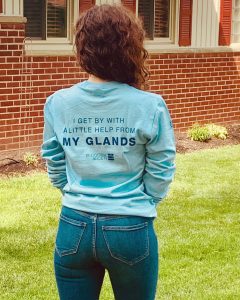
My favorite shirt, sponsored by the Endocrine Society – I get by with a little help from my glands
We were first introduced in high school when I began to study pheochromocytoma – a rare neuroendocrine tumor derived from specialized cells of the adrenal medulla. Within three months, I knew my career would be incomplete without continued research in the field.
During the Student Activities Fair as an M1, I came across the Michigan Journal of Medicine (MJM), a peer-reviewed organization featuring medical students in every role from Reviewer to Editor-in-Chief (in the interest of full transparency, I am currently one of two Editors-in-Chief along with fellow M4, Elie Ellenberg). Our goal is to highlight the incredible passions of the professional student body at the University of Michigan and publish high-quality biomedical, translational, and clinical research to the scientific community at large. Submissions are solicited from members of several graduate programs including, but not limited to, students within the school of medicine, dentistry, nursing, public policy, and social work. Under the guidance of Michigan Medicine faculty, the submitted original scientific work is vetted by teams of Reviewers and a final decision for publication is jointly made by the Editors-in-Chief.
Published annually, the MJM has featured a variety of content beyond traditional original research manuscripts including pieces on medical innovation, case reports, visual abstracts, and educational curriculum recommendations. We want to help our peers showcase their “thing.” If you’ve dreamt up a type of communication we haven’t yet published, send us a message!
Beyond crafting the latest issue, MJM is primarily focused on helping future physician-scientists develop a leadership portfolio within the publishing community and become familiar with the review process. We have an Educational Lead Editor who coordinates a speaker series featuring Editor Bootcamps, Journal Club, and “how-to” sessions for our team. With members from each class of the UMMS community, MJM is an incredible avenue for meeting colleagues outside of your immediate circle and finding peer mentors.
Once an article is submitted to the MJM, it is de-identified (all authors names are removed) and given to a team of three to four Reviewers and an Editor. Reviewers independently assess the manuscript within a given deadline and then come together with their Editor to discuss the necessary changes that need to be made prior to publication. Given the current times, the group session is of course via 2020’s probable new word of the year – Zoom. For me, the team meetings were an incredibly valuable source of information where I learned what more senior medical students focused on when reviewing a manuscript. Not only did this improve my next review, but more importantly, it altered my own writing with a better understanding of what journals are looking to publish.
Whether you love the adrenal gland or any other far less superior part of the human body, the MJM is a place for you to share your research with the scientific community. We would love to hear from you and answer any questions, comments, or concerns at editorinchief.mjm@umich.edu or check out our website (http://www.michjmed.org/) for more information.
by Tiffany Hu | Nov 19, 2020
When I first started medical school, I had a very oversimplified understanding of health insurance. Everyone needs health insurance, I thought; sure, it may be expensive, but not having insurance is gambling with your health. How hard could it be to get patients connected to this potentially life-saving intervention that has been shown to improve health access and outcomes?
Then I got involved in the University of Michigan Student-Run Free Clinic, a wonderful opportunity for students, under the mentorship of faculty physicians, to serve a mostly rural and uninsured or underinsured population in Michigan. Serving our patients opened my eyes to the complexities of health insurance and health disparities in access to care.
I learned that choosing a health insurance plan is terribly complicated. Our patients have many reasons for being uninsured. Our broken health care system has let these patients fall through the cracks.
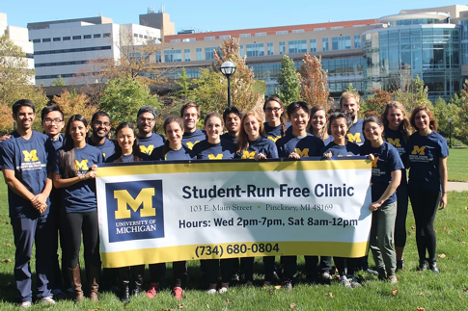
The Student Run Free Clinic Leadership Team during our M1 year (2017-18). It’s hard to believe we’re almost M.D.s now!
As Social Services Coordinator during my M1 year, my goal was to improve health care access by bridging our patients to insurance, helping them navigate and apply for Medicaid (insurance for low-income individuals) or individual Marketplace plans. Many of our patients had been denied Medicaid coverage because their income exceeded the eligibility requirement. I helped them explore Marketplace options and demystified the health insurance jargon—deductibles, premiums, out-of-pocket maximums, etc.
I explained to one patient, “This deductible, $1500, is the amount you have to pay before the insurance will pay for your health care.” She replied, “That’s outrageous! I have to pay this premium every month just to end up paying another $1500 before my insurance will kick in?” Her workplace did not offer health insurance as a benefit, and she was left with no other options. She left and chose to remain uninsured.
Another patient, also ineligible for Medicaid, had lost her job the year prior, and lost her health insurance and access to insulin with it. She delayed care for her diabetes due to cost, and she presented to our clinic with very poorly controlled blood sugars as well as completely preventable, irreversible nerve and kidney damage. I walked her through the lowest-price Marketplace plans. With one glance at the premiums, she said, “We can’t afford this. My husband and I have a car and mortgage to pay off.”
I am grateful that our clinic is poised to help patients in this gap–those who are ineligible for Medicaid but cannot afford health exchange plans. However, it weighs heavily on my heart that our patients are forced to choose between health and other social needs.
I believe that health is a fundamental human right to which everyone should have equal access. The existence of and need for our free clinic suggests that the larger health system has failed our patients. They come to us as a last resort, often after having delayed or forgone medical care because they couldn’t afford it. The process of obtaining insurance or applying for charity care programs is a difficult one to navigate. The process is full of jargon, which further prevents patients from being able to access the health services they need.
I want to make sure that my future patients have equitable access to health. Personally, this involves caring for the whole person and understanding the social barriers that prevent our patients from thriving. Part of my education must center on better understanding the social determinants of health and the health care system. This knowledge will equip me to advocate for policies that improve my patients’ health beyond their medical needs. Being a clinician-researcher will allow me to use data to identify and bridge gaps in our system that our patients are slipping through.
Inspired by my experiences at the Student-Run Free Clinic, I am pursuing a dual degree. I am diving into health services research through U-M’s Master of Science in Clinical Research (MSCR) program. I will take this year to learn more about the experiences of the underinsured and understand the health systems and policies that dictate my patients’ access to care.
The MSCR program has two components: didactic coursework and a research practicum. The U-M School of Public Health offers amazing courses that will build my foundational knowledge in epidemiology and health policy. I am learning to understand and analyze health from a public health framework. Meanwhile, I am immersing myself in a year-long research project to develop the skillset and tools to become an independent health services researcher in my future career.
My research project, led by Dr. Jeffrey Kullgren at the Ann Arbor VA, focuses on helping underinsured patients to better afford their care. We seek to develop an intervention to help patients with chronic diseases—specifically those who are enrolled in high-deductible health plans—to practice cost-conscious consumer strategies in health care. Such strategies may include saving for anticipated health expenses; talking to providers about costs; and comparing health costs between different locations. Patients with chronic diseases require regular medical care. High deductible health plans impose a high burden of cost-sharing. I look forward to discovering how these patients utilize their health plans and practice cost-conscious approaches. I hope that our work makes it easier for patients to understand and plan for their health expenses.
Research has the power to shape policy. I aspire to improve the health system so that all patients can receive quality care regardless of their ability to afford it. I am deeply grateful to have the opportunity to learn and serve at the Student-Run Free Clinic, an experience that has shaped how I see and approach patient care. In the future, I hope to use these new perspectives and research skills from this dual degree year to develop patient-centered interventions and advocate for policies targeted at improving health outcomes and health disparities.
by Sid Perkins, Jesper Ke, Alex Reardon, Sangini Tolia & Jennie DeBlanc | Nov 13, 2020
Earlier this fall, we read concerning news about projected poll worker staffing shortages for the 2020 U.S. Election Day due to COVID-19 concerns. Poll workers play a critical role in ensuring smooth elections by helping process ballots, guiding people through the voting process, and opening and closing polling locations. Seeing the need for young people to step up to meet this gap, we along with David Greco, an M4, decided to recruit fellow classmates to serve as Election Day poll workers in Michigan.
After several recruitment emails, 60 medical and public health students across nearly every medical school in Michigan (with approximately 40 from University of Michigan alone) signed up to serve as poll workers. Many students volunteered to work in sites ranging from Detroit to Washtenaw County to Kent County.
Below are personal reflections from students who worked the polls, many of whom did so at an incredibly busy time in their lives. Knowing we have classmates who care deeply about public health and a thriving democracy is exactly why we’re proud to be at Michigan!
Alex Reardon, Class of 2022: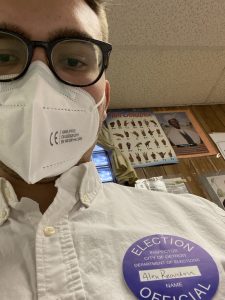
“You all should have been here when Obama was on the ballot,” Mac, our Department of Elections Site Coordinator, crowed. “Lines were out the door and around the corner!” It’s true that, compared to the scene he described, Tuesday, November 3, 2020 was a relatively slow presidential Election Day at Northwest Unity Church, but that didn’t mean there wasn’t some powerful, lowercase ‘d’, democracy afoot.
No-excuse mail-in voting in the state of Michigan helped keep Election Day lines short, thus protecting voters from COVID-19 while they exercised their civic duties on their own schedule. Without a photo identification requirement, we did not have to disenfranchise our neighbors who arrived with just their work badges, expired licenses, or who had no photo ID at all. Same-day registration meant we could remedy wrongful voter roll purges and assist first-time voters who acutely felt that their voices were meaningful this year.
The electoral system needs healing. Voter suppression and the downstream effects it has on the body politic are pervasive and insidious, but one 16-hour day at Detroit’s 389th precinct gave this future physician hope for a cure.
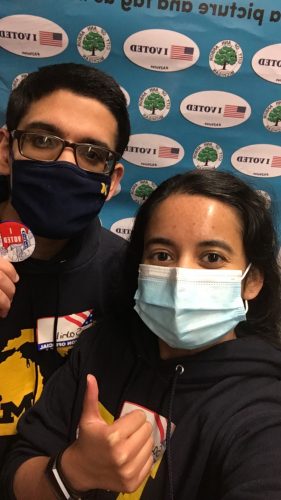 Sangini Tolia, Class of 2022:
Sangini Tolia, Class of 2022:
My brother Sahil and I live together in Ann Arbor and do nearly everything together, so it was only natural that we’d work together as poll workers this year. I had first worked the polls in Ferndale, Michigan as an undergraduate student, and I felt that it was so important to share the beauty of this process with my brother.
We were stationed at Community High School in Ann Arbor, and it was so exciting to see members of the community streaming in throughout the day. I certainly won’t forget the elderly woman who couldn’t find the elevator and climbed two flights of stairs with her cane, absolutely determined to cast her ballot. She was exhausted, so we got her a wheeled desk chair to push her to each station in the room. When she fed her ballot into the tabulator, cheers and applause erupted from all of us. It was humbling to directly witness how much meaning and power is held in the act of voting.
For the rest of the week, as I followed the tallies on the news, I thought about how each number represented a person making their voice heard. Our work as physicians extends out into the community, and that includes making sure everyone has equitable opportunities to participate in democracy. I know that we’ll both be back for the next election!
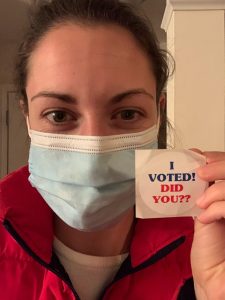 Jennie DeBlanc, Class of 2022:
Jennie DeBlanc, Class of 2022:
When I heard that the Detroit Department of Elections was looking for more workers to help count the massive number of absentee ballots expected in the 2020 election, I have to admit that I hesitated. I could think of a number of reasons not to commit to two very full, very long days spent counting ballots — the first and foremost being the USMLE Step 1 exam looming ahead. When I eventually signed up, I wondered if I would regret the commitment, and wondered how much “oh my god why am I not studying right now” anxiety was coming my way.
It turned out to be one of the best experiences of my life. Being in a place where hundreds of people had come together to work tirelessly to promote democracy and to allow all voices to be heard was inspiring. Even when there were tense moments with protestors in the building, and questions were being raised all over the country as to the legitimacy of our process, I saw all those around me put their heads down and continue to work tirelessly for democracy. And for the first time in quite awhile, I had hope. Hope that the energy I saw in the building that day will continue — not just through this election process, but for future elections, both big and small. Hope that we would continue to work on examining the flaws in our electoral system, and to keep demanding change. Hope that one day, we will make voting accessible, safe, and easy for ALL people in America. And that sort of hope is definitely worth missing a day or two of studying.
by Allyse Zondlak, Quintin Solano, Maia Anderson & Ryan Eton | Nov 5, 2020
Learning how to be a doctor is a lot like learning how to bake. You read the book, learn the steps, try it out, and then you end up with cookies. But the best bakers (aka my grandma) will tell you that the real learning comes when the cookbook is taken away. It forces you to think about the individual ingredients and steps in a new way. And you start to appreciate how each individual step can make an impact on the final product. It can be frustrating, but once you grasp this new way of thinking you can make more than just cookies.
In medical school we spend our first year learning the basics: anatomy, physiology, pathophysiology, and numerous treatments for countless diseases. We also learn to apply this knowledge to clinical vignettes through our doctoring and chief-concern courses with the help of faculty members. All of this learning and practice is in preparation for the clinical clerkships when our book is taken away and replaced with a pair of scrubs.
Once we took our first steps into the clerkship year, we quickly learned that patients almost never present exactly how the book teaches us. This is especially true in surgery. While we were primed to recognize standard surgical pathology during our M1 year, decision-making in surgery remained a mystery to us. We have learned how to diagnose a patient with acute cholecystitis, but how can we determine if he is a safe and appropriate surgical candidate?
We thought it would have been helpful to begin learning these critical thinking skills earlier in our medical training. This is how the idea of ‘Think Like a Surgeon’ came to be. Our goal is to provide students with early exposure to surgery and give them tools for success when they are on their surgery clerkships. We wanted to create an interactive learning experience to help students build a mental framework for surgical decision making.
At Michigan Medical School you do not have to go further than an email to get connected with leadership to start making your idea a reality. We were connected to Maia Anderson, a PGY-4 Surgery Resident, who not only wanted to make our idea happen, but supported it with her time and knowledge to help improve it. We created the sessions together with Maia and Ryan Eton, another PGY-4 Surgery Resident, who selflessly offered their time to moderate the sessions. They also made sure we, Allyse and Quintin, ran the majority of the session while they provided the group with higher level knowledge as the session progressed.
We hold monthly sessions that are split into two groups: Pre-Clinical (M1) and Clinical (M2/3/4/MSTP) students. We split the sessions into pre-clinical and clinical because trainees are at different parts of the curriculum and therefore have different needs. Pre-clinical trainees take a deeper dive into the pathophysiology, while Clinical trainees go deeper into the decision-making and treatment process. In each session we include relevant anatomy, physiology, and imaging.
‘Think Like a Surgeon’ offers an informal, educational environment to interact and gain exposure to the field of surgery through discussion between surgery residents and interested medical students. We hope for trainees to feel inspired to consider surgery early on and, even if students are not planning for a career in surgery, we hope for them to gain useful skills and knowledge they can apply to their interests. For future sessions, we are looking for student volunteers who can design and lead the sessions with the support of our residents. Our first few sessions have received positive feedback from students and we look forward to many more!
by Cayla Pichan | Oct 29, 2020
March 11, 2020, was a memorable day, not only because it was my 25th birthday, but because it was the day when COVID-19 was declared a world-wide pandemic. I was on my Neurology rotation, and my fellow classmates and I did not know what this meant for all of us currently working and learning in the hospital. When the AAMC recommended that medical student clerkships should be halted, we were promptly removed from our clinical duties and instructed to stay home to stay safe. We went from buzzing around the hospitals and clinics to our couches and Animal Crossings in the matter of a day. We had spent the entire year playing an important role in patient care and doing hands-on learning on the various clinical teams throughout the health care system, and all of the sudden the world, our education, and our connection to patient care halted. A lot of us like myself felt helpless in wanting to do something.
Within 24 hours of being pulled from the hospital wards, a group of students created the M-Response Corps (MRC), and within a week, more than a dozen volunteer initiatives were formed, aimed at helping wherever medical students could be of use – from making hand sanitizer to working at the PPE donation site. Dr. Mary Blazek reached out to the MRC requesting help to target a specific population who were at a significant disadvantage and increased risk because of COVID-19 – the Geriatric Patient Population. While many patients were easily and seamlessly able to utilize the technology they were already accustomed to, to connect with family members as well as complete virtual doctor’s visits, geriatric patients are at a significant disadvantage given their lack of access to and comfort with technology. Although 81% of Americans own a smartphone, only 53% of those over age 65 do. While 73% of Americans have broadband internet service at home, only 59% of people 65 years or older do. Because geriatric patients are at increased risk of morbidity and mortality from COVID-19, it felt necessary to prioritize remote connections with these patients. Under the guidance of Dr. Blazek, I got to work on creating GET Access – Geriatric Education on Telehealth, creating an algorithm and procedures manual. We recruited medical student volunteers from the MRC and began making calls to geriatric patients within the community who had upcoming phone visits in an effort to convert them to video visits.
We received resounding positive feedback from the providers who our volunteers were servicing, and increased demand prompted us to expand our volunteer pool to include University of Michigan undergraduate students as well. With the clinical volunteer opportunities next to none for undergraduate pre-medical students, we received extensive interest and were able to expand our team to 26 total volunteers. Over a 12-week period during the initial height of COVID-19, volunteers made 219 total calls. The GET Access Program volunteers were successful in teaching and converting many visits to video that the schedulers were unable to do on a first pass and achieved an 88.75% conversion rate from phone to video visits. Providers whose patients worked with our GET Access volunteers had a video visit rate of 43% compared to 19.2% prior to participation in the program.
Patients appreciated the increased comfort of video visits. The husband of a 93-year-old patient who assisted with his wife’s video visit stated, “We even liked it better than sitting right there. It was more comfortable being at home.”
The providers we worked with were also grateful to have the help, “My patients loved the contact and the help – they are not technologically savvy and valued the expert help and the friendly encouragement.”
The volunteers also enjoyed working with the patients. Undergraduate student volunteer, Faith Chang, describes a lovely experience with one patient who was particularly struggling with technology, “It was really difficult but at one point she said, ‘Computers just make me so anxious, and when my kids try to help me they always end up yelling and I get so anxious my stomach hurts and I get nauseous. But not once working with you has my stomach hurt one bit. Your patience and kindness will serve you well in life.’ She was just so sweet and that was a really nice experience.”
“I really appreciated my time volunteering with Get Access because I was able to interact with patients while social distancing. It was so much fun to get to know them and help them through their technology questions. For some patients, I probably spent more time chatting about their grandchildren than talking about Zoom. It was also helpful to learn how to do a virtual visit since I’ll be seeing patients virtually during the clinical year.” Alexandra Peirce, M2
“GET Access has created a channel of communication with a very wise and resilient patient population. It has made me realize not only the importance of improved communication between patient and provider in these socially distanced times, but also the unique bonds that can be formed between college students and geriatric patients.” Annika Dhawan – U-M Undergraduate Student
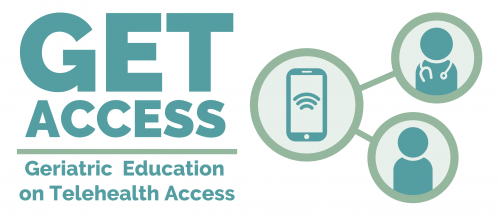
Although the urgency of our program’s need has dissipated, we still are looking forward to offering these services to the geriatric population. We believe this is important work that still needs to be completed, especially as the winter weather approaches which may prompt patients to prefer video visits over in-person visits. We are currently working to expand to other clinics within the University of Michigan and eventually would like to adapt our materials to accommodate other health care systems outside of Michigan Medicine to help the greater Ann Arbor and nearby Ypsilanti communities.
Overall, GET Access has given me a purpose in a time where medical students initially felt pretty useless at the onset of COVID-19. This project brought (and continues to bring) me a lot of joy. Communicating with older adults, especially during a time when social isolation is at an all-time high, was the most enjoyable and special part of this project. Although I already knew I had an interest in geriatric medicine following my exposure to the field during my internal medicine rotation, this project really solidified my desire to consider working with this specific population of patients who often are left to the wayside, for the rest of my career. Projects like these are what make the University of Michigan Medical School so unique. Michigan creates a space of creativity and freedom to pursue and combine our personal interests outside of the classroom and wards with our future career interests, and does whatever it can to support students like me along the way.
The creation and sustainability of the GET Access Program could not have been successful without the help and guidance from faculty advisors Dr. Mary Blazek & Dr. Lillian Min, and student co-leads Clare Anderson, Cassidy Merklen, and Kinsey Vear.





 Sangini Tolia, Class of 2022:
Sangini Tolia, Class of 2022: Jennie DeBlanc, Class of 2022:
Jennie DeBlanc, Class of 2022: